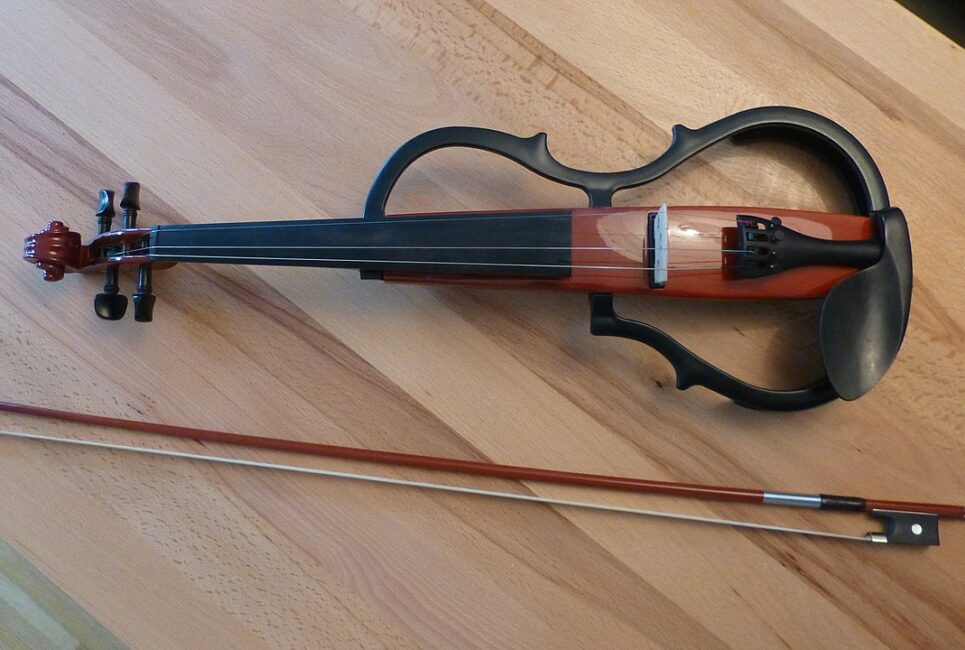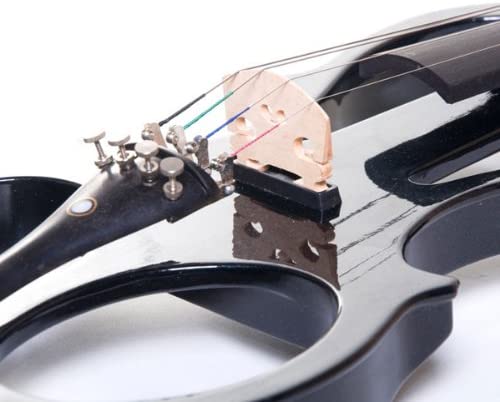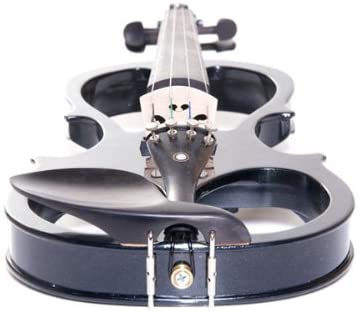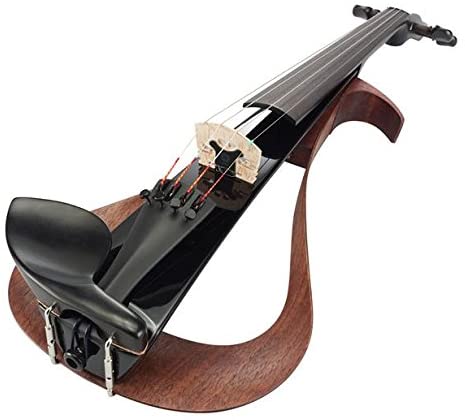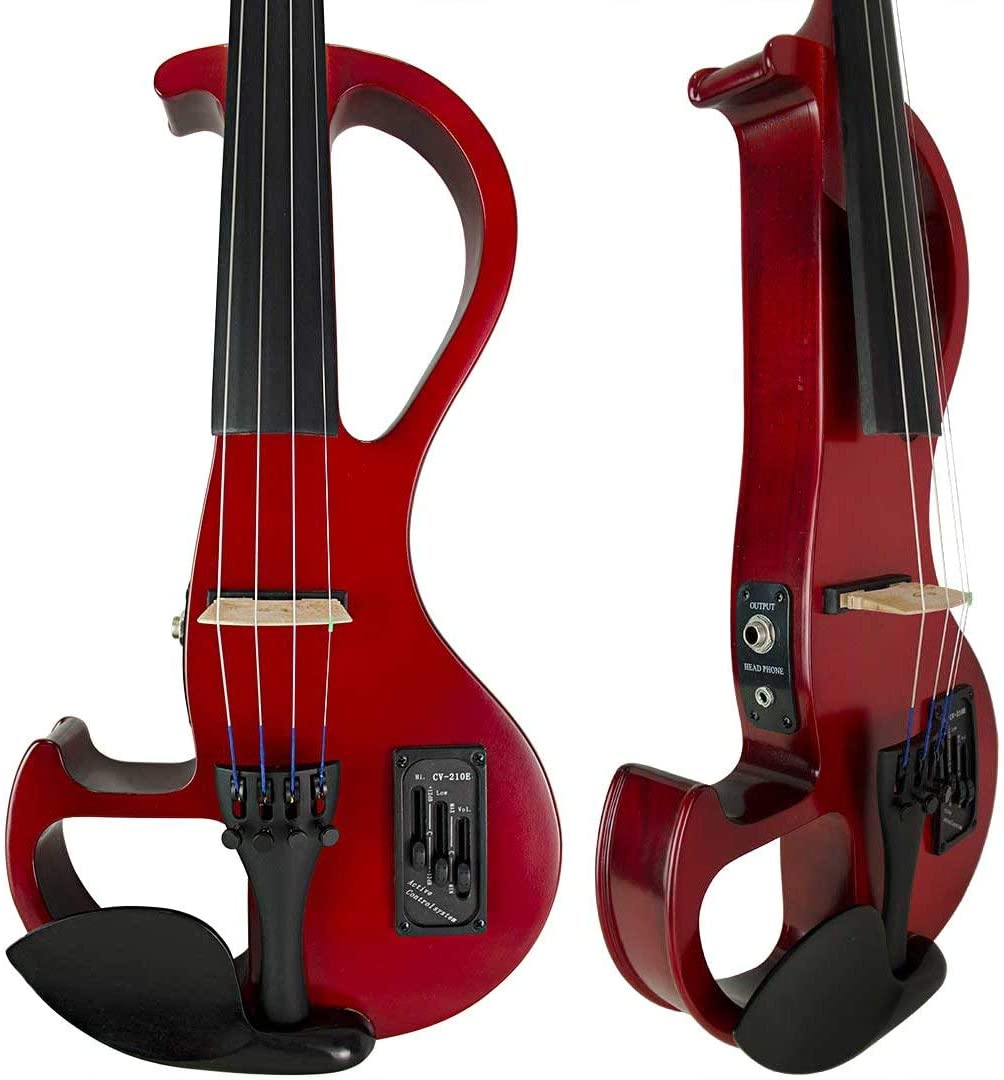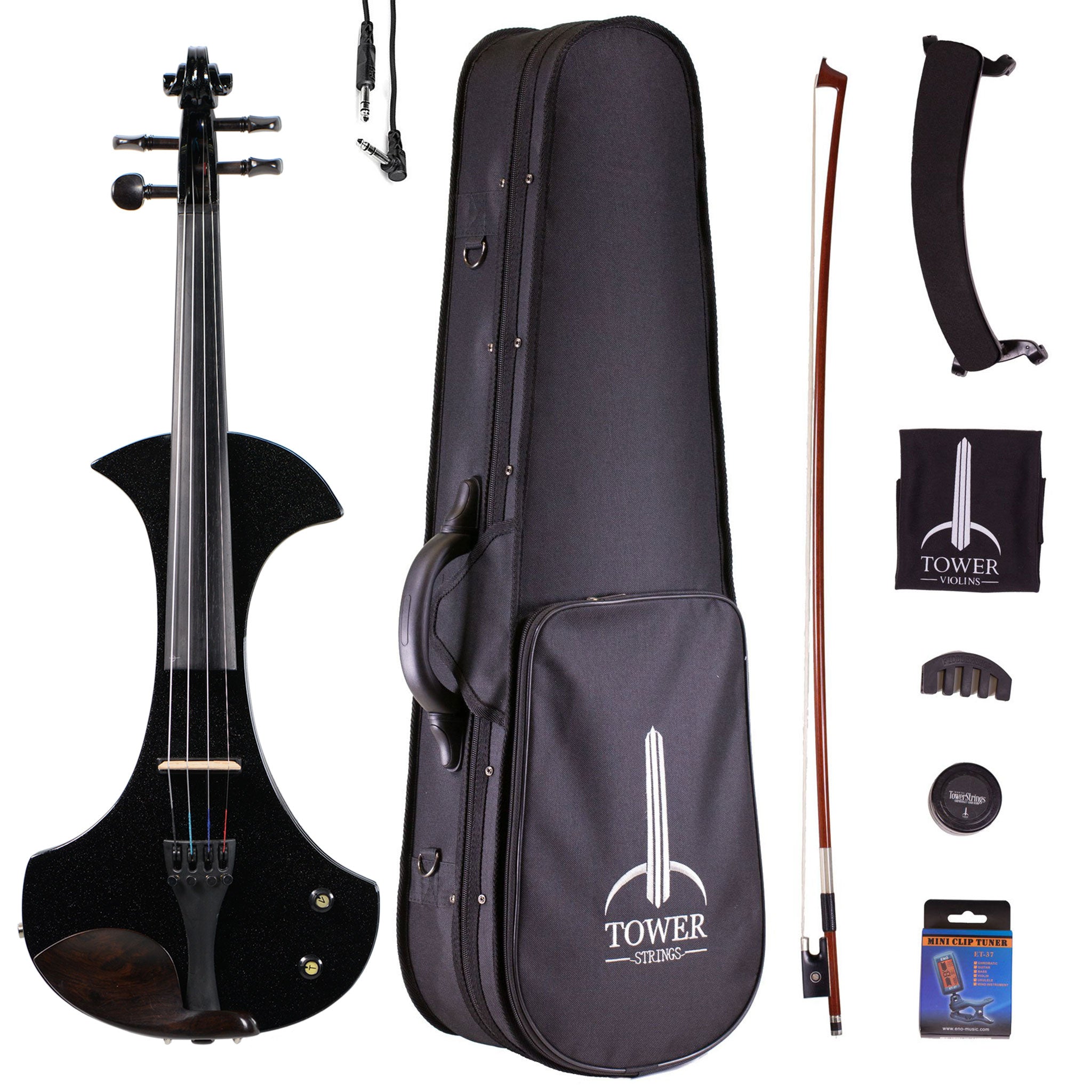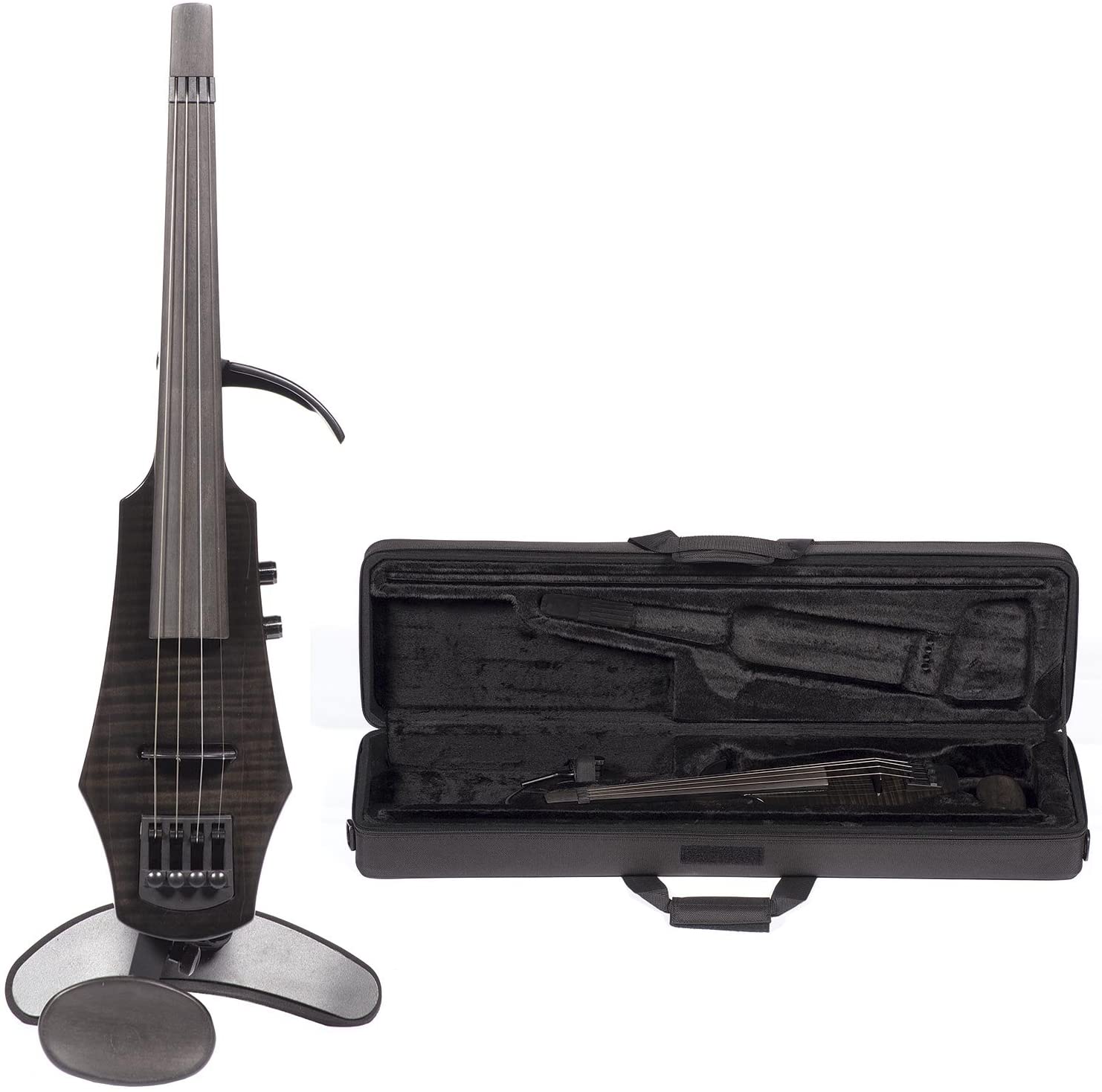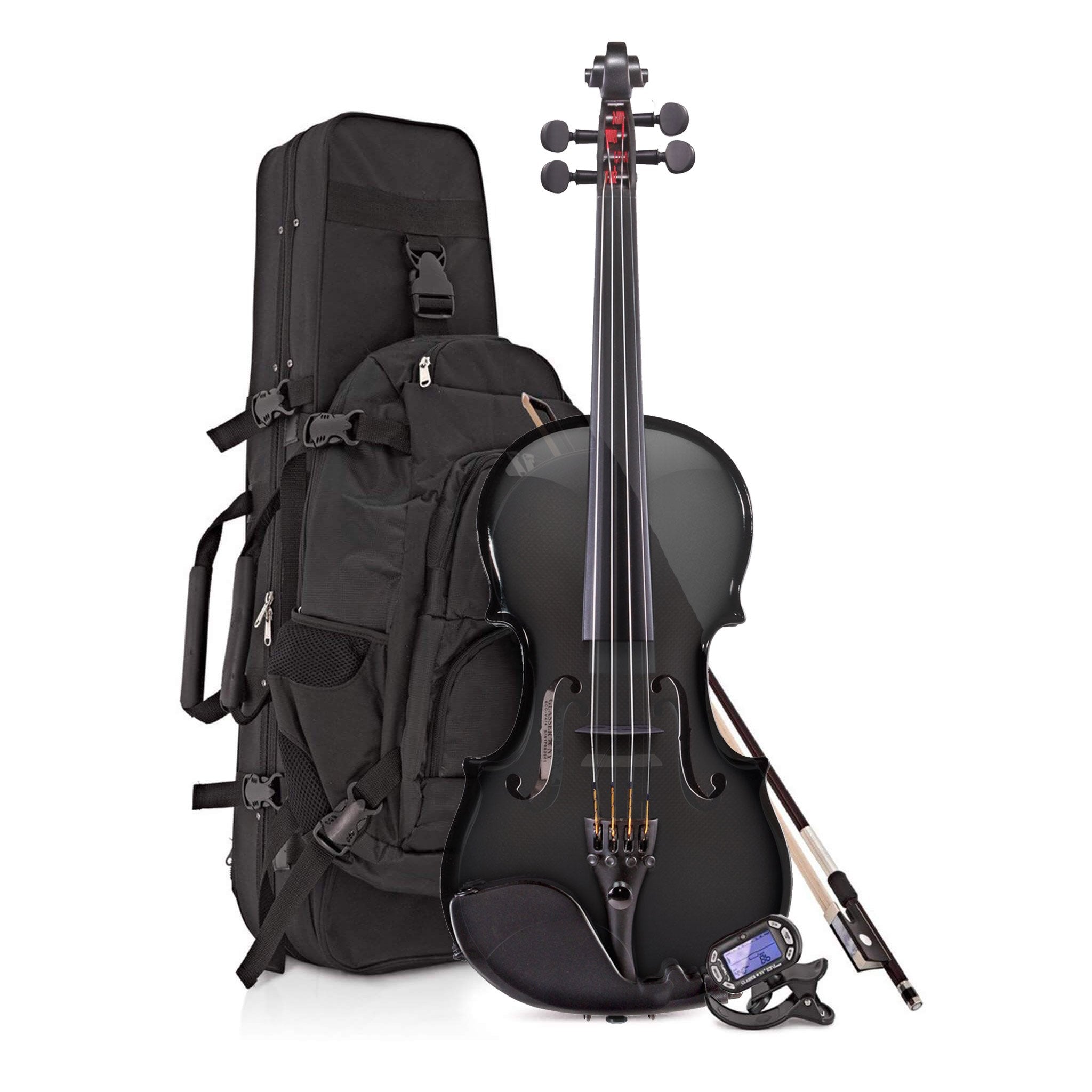- Best Fretted Violins Guide - May 31, 2022
- Best Yamaha Violins Brand Guide - April 13, 2022
- An Honest Mendini MV300 Review - March 31, 2022
When I was a child, the violin was associated with classical music and orchestras. While that is still the case today, we are starting to see more and more violinists breaking out of the classically trained mold. Today we see violinists like Lindsey Stirling, Taylor Davis, Black Violin, and Emilie Autumn, who are changing the way we look at the violin one album and show at a time.
This is due to the Electric Violin, which allows for built-in amplification, looping, and effects. Cecilio wouldn’t be one of the top student violin retailers if they didn’t include at least one electric violin in their lineup! So let’s check it out!
Pros, Cons, and Bottomline
This is a basic electric violin. There isn’t anything special about it, but it gets the job done. There’s a style and a color for nearly everyone, including left-handed violinists. I’m partial to the 4NA in the red mahogany. The pick-up and built-in amp on these violins are basic and primarily built for at-home silent practice. The tone and volume controls allow for small easy adjustments for those who would use this violin for a gig, although I don’t recommend that for various reasons I’ll discuss below. The reviews complained of the harsh tone and included strings, similar to my complaints about this violin. Overall, it is suited for someone interested in learning about effects and looping or who wants to become familiar with Ableton but doesn’t want to spend a ton of money right away. An excellent electric violin worth taking to gigs will cost $400 to $500 minimum, but there are a few better budget options out there.
Pros
- It comes in 4 styles for right-handed people
- It comes in 2 styles for left-handed people
- It comes in 5 colors
- Ebony fingerboard
- Built-in amp, tone control, volume control, and hookups for external amps and headphones.
Cons
- Location of jacks for amp and headphones gets in the way
- Poor quality pick up
- Poor quality accessories
- Not suitable for recording or gigs.
Electric Violins: The Guitars Rival
Guitars used to be associated with classical music, but they are more associated with country and rock music in our modern world, thanks largely to the electric guitar. The electric violin follows a similar concept: you build a solid violin body from tonewoods and then add electronics to produce the resonance and projection you would otherwise receive from the F-holes.
Pick-ups are the main electronics on electric violins and enable them to be hooked up to an amplifier. There are many different types of pick-ups, and they attach to violins in various ways. I typically see pick-ups that go into the body under the bridge, but higher-end violins will have different pick-ups that connect directly to the bridge’s wood. The jacks for the headphone, mic, and amp can be found in various places on electric violins. I prefer them on the side, with tone/volume controls on the body itself. The acoustic violin hasn’t been forgotten about. You can easily add pick-ups to acoustic violins and even quickly take them off when they aren’t needed.
Unlike an acoustic violin, electric violins don’t get the same amount of tone help from the tonewoods used or the shape. While it’s still important and you want a violin made from quality materials, this has opened a door for violins made from different woods and types of materials, most notably carbon fiber. Still, the rest of the instrument is more or less the same, with some notable exceptions like the NS Design electric violins, which completely abandon tuning pegs and the scroll. The fingerboard should be the standard ebony, and the fittings will vary and sometimes be custom-made.
The primary value in an electric violin for me lies in its ability to be manipulated via effect pedals or looped without attaching another device to my acoustic instrument, similar to an electric violin. For most students, the value of an electric violin comes from its ability to be practiced quietly. The headphone jack and preamp allow you to plug headphones into the violin and practice quietly, you will still make noise through your violin, but it will be heavily muted with the full sound coming through the headphones. This is amazing for people who live in apartments, dorms, or want to practice when others are sleeping.
Unforuntantelly, electric violins will never replicate the nuances of an acoustic violin. New students should focus their efforts on acquiring a good quality acoustic violin and pick up an electric once they’ve mastered the basics in a few years to expand their horizons.
However, electric violins can rival electric guitars thanks to their versatility and ability to use similar electrical components to a guitar. You can watch Lindsey Stirling and her guitarist/keyboardist dual it out here to get a taste of how similar their ranges are. Fun fact: this piece was initially played with her keyboardist Gavi on the keytar, a portable synthesizer worn similarly to a guitar.
The Cecilio Electric Violin: Basic as Basic Can Get
As I’ve mentioned, there isn’t anything special about this violin, how it sounds, or the accessories it comes with. The sheer amount of accessories is lacking for a Cecilio instrument. It’s not suitable for gigs or recordings. It’s more of a musician’s toy than a serious instrument.
This violin comes in 4 styles CEVN-1NA-4NA for right-handed violinists and two styles, CEVN-L1NA and L2NA for left-handed violinists. The only difference between styles is the body’s shape, but everything else ultimately remains the same. There are five colors to choose from, Black, Blue, Mahogany Red, Yellow Maple, and White. I like red and white colors. Since this violin is so cheap and electric, I’m rather inclined to paint it and use it as a prop piece. Unlike acoustic violins, electric violins with solid bodies can be customized with paint, rhinestones, decals, and stickers without harming their overall tone or playability. I put stickers on my electric violin to give it some personality.
The body is made from solid maple and specifies hand-carved, but that doesn’t matter in this case. The fingerboard and fittings are pure ebony and have a pearl inlaid detail. The tailpiece has four detachable fine tuners, which are a must for these violins. They can easily be replaced if they break and are essential because the pegs tend to slip or be of poor quality on these violins.
There is no mention of the type of pick-up or preamp used on this violin, but they do include the 9V battery needed to get you started. My biggest frustration is the size and the placement of the jacks on the violin. The jacks are mini-jacks, not the standard size you find on music equipment like amps. This is fine for most headphones, but it becomes cumbersome depending on your existing equipment as you need a special cable or an adapter for your equipment. Additionally, the placement of everything is on the back of the violin, right where your shoulder stops. Meaning that the cord will get in your way as you play or make it hard to hit specific notes. I prefer it on the side where I can push the cable over my shoulder. The best solution is to have a wireless set-up, but this violin isn’t worth that type of equipment. These things won’t matter if you are only using the violin for silent practice, and in many ways, that is how this violin was designed.
There are two adjustments controls included tone and volume. The volume knob will adjust the violin’s volume just a little bit which is nice for small tweaks. The tone knob is meant to add some bass to the overall sound of the violin. Since this is such an inexpensive instrument, it doesn’t do anything, and you will need to rely on your amp to adjust the bass. The knobs are located on the back of the violin, which can be difficult for very quick adjustments.
The accessories include a case, bow, cord for an amplifier, rosin, and headphones. None of these things are that great, especially the headphones. There is no mention of the type of strings, but I imagine they are the Cecilio in-house brand which can be thrown out. You can replace the strings with Dominants or even NS Electric strings if you would like. Along with upgrading the bow, you will have better sound and playability. However, that money could be spent on an electric violin of higher quality with better accessories or one that even includes an amp.
Okay, but What Does It Sound Like?
The only two words that can accurately describe the tone of this violin are overly bright and tinny. This is a two-fold problem that requires a decent bit of money to solve if you don’t already have the equipment. The first problem, as mentioned, is the strings. They aren’t good quality and will probably break the first time you tune them. Electric violins are well suited for steel strings like the NS Electric or D’Addario Preludes. Still, this violin needs some warmth, so I’d go with synthetic strings like Dominants or Fiddlershop Strings. This will add another 35-60 dollars to the cost of this violin.
The second problem is just the lack of quality material used to produce a good tone, in this case, the electronics. The pick-up is a critical aspect, and to have an electric violin worth playing; you need a good pick-up to produce a good tone. With no mention of what kind of pick-up being used, it’s likely something cheap. Manufactured in-house or bought in bulk on sites like Aliexpress. To give this violin a better tone, you need to add reverb, among other effects, but this can be expensive if you don’t already have the equipment and can present a learning curve for some.
Because of these reasons, I’d only recommend this violin to someone who needs something cheap for silent practice. For students serious about the violin or want something to add spice to their gigs, I would recommend more expensive but higher quality options from Tower Strings, Bunnel, Yamaha, and NS Designs, along with one special mention.
My Favorite Electric Violins
Electric violins come in all sorts of shapes, colors, designs, and components. You can find them in 4 and 5 strings versions, with pegs or without pegs. The electric components will vary as well. Many people even try to make an electric violin or two as a hobby or fun project. With so many on the market, it can be challenging to track quality ones. These electric violins have been chosen based on quality, reviews, price, and my own experience.
Top Pick – Yamaha YEV-104
My top pick is the Yamaha YEV-104 4 String Violin. Yamaha is well known for making quality electric violins and has been used by many different violinists worldwide. Additionally, they are the leader in producing many different band instruments like clarinets and saxophones. If you are looking for an electric violin for recordings or gigs, you will find a lot of value in this instrument. The body is made from maple, rosewood, spruce, mahogany, and walnut, giving it an interesting natural modern look that stands out against the colors of other electric violins. The pick-up on this violin is a Yamaha Dual Piezo Passive bridge pick-up meaning it requires an amplifier to get the full sound but doesn’t require batteries or preamps. Headphones will need to be run through your amp, and the pick-up is installed directly on the violin’s bridge. This violin comes strung with D’Addario Zyex strings but doesn’t have any accessories. It has a lovely mellow but even tone with a nice ring on the upper register; there’s a reason it’s a gold standard for those new to electric violins.
Budget Pick – Bunnel Edge Electric Violin
I included two budget picks because chances are, if you are looking at Cecilio electric violins, you don’t want to spend $700 on the YEV, and I get that. I don’t even own a YEV because of the price. My first pick, the Bunnel Edge Electric Violin, contains a ton of bang for your buck and has enough quality to perform on stage or in a recording studio. The violin’s body is solid maple with an ebony fingerboard and fittings.
The pick-up is an active Piezo ceramic pick-up similar but not quite the same quality as the one on the YEV, but it still produces a well-rounded but slightly bright sound. It’s also an active pick-up with a preamp which allows you to plug headphones in and practice silently. The 1/4 inch output jack and standard 3.5mm headphone jack is on the side of the violin allowing for the cable to be placed behind you and not in the way. The tone and volume controls are on the front of the violin allowing for easy adjustments while playing. Along with the quality of the build, this violin comes strung with D’Addario Prelude strings, a quality brazilwood bow, an upgrade case, rosin, an amp cable, decent quality headphones, and a small table amp. Everything you need to try is an electric violin.
Budget Pick 2 – Tower Strings Electric Pro Violin
My second budget pick is the Tower Strings Electric Pro Violin sold exclusively at Fiddlershop. I currently own this electric violin, and I’ve been extremely happy with it. This upgraded budget electric violin is a nice step up from a Cecilio model. It features a solid maple wood body, an ebony fingerboard, and fittings. A carbon composite tailpiece with built-in fine tuners. The built-in pick-up and preamp is very similar to the one on the Bunnel Edge Electric Violin and allows you to practice silently.
The tone and volume controls are located on the front of the violin and have a minimal effect but do warm or brighten the tone a little bit. There is a single 1/4″ audio jack on the side of the violin and a headphone jack on the back. I never used the headphone jack because my shoulder rest covered it, but with some adjustments, it’s useable. For an electric violin, it’s incredibly light and easy to play, although I sometimes struggle with hitting the G string easily. The overall tone is pretty even and balanced. I wouldn’t classify this violin as warm or bright it sits firmly in the middle.
Funky Design – NS Design WAV-4
NS Designs has become some of the most well-known electric violin makers thanks to their odd but stand-out design. Unlike a regular violin, electric or acoustic, the NS Design WAV-4 and its counterparts are made without a scroll or pegbox. Instead, you tune this violin using four specially designed fine tuners at the bottom. This is very attractive because tuning with fine tuners can produce a much closer tune. You put new strings on backward with the ball end going through the top of the violin and the bottom of the string threaded into the tuner on the tailpiece. It’s quite an attractive design that has caught the eyes of many violinists.
The body of these violins is made from maple with ebony fingerboards and maple bridges. The pick-up is a passive Polar pick-up system that doesn’t require batteries. The tone controls are on the side, and the output jack is on the violin’s back. It comes strung with NS Design strings made from electric violins, and it comes with a hard case. You can purchase this violin in both 4 and 5 string versions.
Honorable Mention – Glasser AEX
The Glasser AEX is an acoustic and electric violin made from Carbon Composite. Carbon Composite string instruments first started appearing in the early 2000s, but they were costly. Luis and Clark is the first and most well-known maker of carbon fiber instruments, but Glasser and Mezzo Forte have now joined the ranks. Glasser is a budget line of Carbon Fiber violins, with their cheapest outfit coming in at just over $1,000.
Unlike others on this list, this violin has a hollow body with F-holes similar to an acoustic violin to allow projection and resonance when not hooked up to an amp. The pick-up is a Bartolini preamp that needs two triple-A batteries, with the jack located in the chinrest and the EQ knob on the tailpiece. The pegs are geared planetary pegs that behave similarly to guitar pegs in tune. I like these pegs and am getting put on my acoustic violin. The strings are Larsen, which are excellent, high-quality strings. Alone I find the tone empty but not offensive, it sounds very even, and it’s easy to draw a pleasant tone out of. The AEX comes in nine different colors, while the more expensive version comes in a weave style, but that is the only difference. The outfit includes a case, carbon fiber bow, and tuner.
The biggest draw for these instruments is that they are resistant to drops, scratches, temperature, humidity, and weather changes. You can even play them in the rain!! This makes them super durable for traveling musicians or music videos in conditions that would ruin wood instruments. I still wouldn’t use one of these violins for stunts. While they may be resistant to drops, that doesn’t mean they are unbreakable.
FAQ
Answer: Of course, but not in the same way you would on a guitar, and you will need some help along the way. I’m a firm believer you can shred on any instrument if you want; it’s all in how well you play. Guitar shredding combines complex techniques and effects to produce epic music passages. A good violinist can shred a violin if they play well; if you don’t have money to invest in electronic effects, many amps have an overdrive button that will distort the sound.
If you want to check out some violin shredding, check out classically trained violinist Emilie Autumn, shredding the violin to her song Face on the Wall. While I have no clue what violin she is playing, I play the same song using the overdrive on my amp, producing the same effect.
Answer: No, but they are highly muted and can’t be heard through walls with the door closed. VIolins with active picks that allow you to play with just headphones are perfect for those that live in apartments or practice at odd hours. However, they aren’t a substitute for a good acoustic violin or practice time with that.
Answer: Active pick-ups require power and release a wider, more dynamic sound to the amp, giving players more control. While passive pick-ups don’t require batteries or headphones to play, they also don’t produce as dynamic as a sound and are prone to picking up interference.
Final Thoughts
The Cecilio electric violin is a basic violin only suitable for silent practicing. Due to the electronics location and poor materials, it won’t perform well on stage or in a recording booth. This violin will bridge the gap if you need something for the occasional silent practice. If you are looking for a good quality electric violin that will allow you to learn about everything electric violins have to offer, try out the Bunnel Edge or Tower Strings Pro. If you need something closer to the professional end of the spectrum, check out the YEV-104 or NS Design WAV 4. If you need a durable violin that doesn’t require an amp, then the Glasser AEX is your best bet!
Looking for more interesting readings? Check out:

